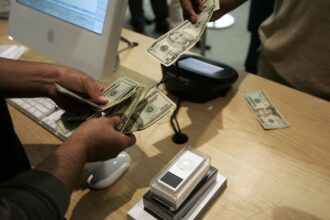Silicon Valley Bank’s (SIVB
VB
The most accessible and frequent data is bank stock prices. Bank stocks have been particularly hard hit, with the KBW Bank index down about 22% year-to-date. The relatively good news is that bank prices have remained around the crisis lows and have not plunged further. In addition, the broad market has rebounded, which signals less concern about a financial crisis infecting other sectors. Unfortunately, stock prices are very fickle and can reflect emotion rather than facts in the short term. Aside from the government money market mutual funds asset flows, all the following bank data come from the Federal Reserve’s H.4.1 and H.8 weekly reports, released on Thursday and Friday, respectively.
A straightforward way to see the severe stress in the U.S. banking system is the magnitude of bank borrowings from the Federal Reserve via the discount window. Borrowing from the discount window is generally avoided by banks, but the facility can provide emergency liquidity. While the amount borrowed from the discount window has declined from the highs, it remains only slightly below the highest level registered during the Global Financial Crisis.
However, just looking at the discount window understates the support currently provided to the U.S. banking system. Following the collapse of Silicon Valley Bank, the Federal Reserve announced a new facility to help banks meet withdrawal requests from depositors and restore confidence. The Bank Term Funding Program (BTFP) allows banks to borrow up the face value of any government bonds held in the bank’s portfolio at a very reasonable rate. The Paycheck Protection Program (PPP) facility was created in 2020 to provide support during the pandemic. The other credit is the support of the bridge banks, operated by the Federal Deposit Insurance Corporation (FDIC) until they can be sold or liquidated.
With the seizure of Silicon Valley Bank and Signature Bank, discount window and bridge bank credit usage soared. Last week, the use of the Fed bank facilities was driven by the bridge banks. The decline in discount window borrowing was likely a shift in borrowing to the BTFP. Overall, this relatively modest increase in Fed bank lending bodes well that the severe impact of the banking crisis has not spread far beyond the banks already on our radar, including First Republic Bank
FRC
Overall, there was good news that bank deposits stabilized and grew slightly after the large outflow the previous week. Notably, the 25 largest banks, which include many midsize regional banks, increased deposits by almost $120 billion last week. More troubling is the draining of nearly $110 billion from the smaller banks.
Cash has continued flowing into government money market funds outside the banking system. This movement likely reflects a hunger for higher yields and a flight to safety from the banks.
Banks made themselves more liquid and able to withstand deposit outflows by increasing cash on their balance sheets.
Despite the current crisis, banks continued to make loans. Loan growth will likely slow as banks hoard extra liquidity to bolster their defenses against possible additional deposit flight and increased loan losses.
In summary, the U.S. banking system has begun showing signs of stabilization from the crisis. However, it is far too early to declare victory, and confidence in the banking system has been severely dented. The current banking challenge remains one of liquidity for most banks rather than an issue of solvency. Pressure on some perceived weaker banks is likely to continue, and policymakers may be forced to provide additional support. The deposit outflows from the smaller banks bear watching closely as more issues could arise if it continues. Smaller banks are the leading provider of commercial real estate loans so that sector could face less credit availability.
Read the full article here










